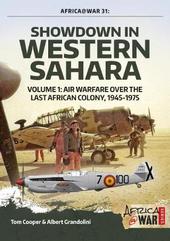
|
Showdown in Western Sahara: Air Warfare Over the Last African Colony, 1957-1991
Paperback
Main Details
| Title |
Showdown in Western Sahara: Air Warfare Over the Last African Colony, 1957-1991
|
| Authors and Contributors |
By (author) Tom Cooper
|
|
By (author) Albert Grandolini
|
| Series | Africa@War |
|---|
| Physical Properties |
| Format:Paperback | | Pages:88 | | Dimensions(mm): Height 297,Width 210 |
|
| Category/Genre | African history
National liberation, independence and post-colonialism
Military history |
|---|
| ISBN/Barcode |
9781912390359
|
| Classifications | Dewey:964.802 |
|---|
| Audience | | Professional & Vocational | |
|---|
| Illustrations |
110 photos, 10 maps, 12 colour profiles
|
|
Publishing Details |
| Publisher |
Helion & Company
|
| Imprint |
Helion & Company
|
| NZ Release Date |
15 May 2018 |
| Publication Country |
United Kingdom
|
Description
The former colony of Spanish Sahara saw frequent outbursts of tribal and ethnic rebellions already while ruled by colonial authorities, in the late 19th and through into the early 20th Century. Its vastness and distances dictated the application of air power in response. While most of these attracted next to no attention in the English-language media, at least the large-scale operations of the Spanish colonial authorities of the late 1950s became notable for the final combat deployment of the famous Messerschmitt Bf.109. Nearby, their common history as former French colonies resulted in a short war between Algeria and Morocco, which in turn prompted an arms race that lasted well into the 1980s. Amid growing resistance from natives and increasing international pressure, Spain withdrew from Spanish Sahara in 1975. Almost immediately, a major war erupted as Sahrawi nationalists - organized by the POLISARIO front - engaged in guerrilla warfare against Moroccan armed forces deployed to secure the northern part of the country, and Mauritanian forces deployed in the south. Characteristically for this period, POLISARIO's insurgency was often misinterpreted as `Soviet-influenced' in the West, although the rebels never adapted any such frameworks for their operations and tactics like those of Mao Zedong. On the contrary, while Algeria at least tolerated their bases on its soil, it was Libya that provided most of support for insurgency, eventually enabling it to defeat the Mauritanian military slightly over a year later. Combined with POLISARIO's raids deep into Mauritania this prompted France to launch a limited military intervention in support. While tactically successful, this proved insufficient: Mauritania withdrew in 1979 after signing a peace treaty. Morocco continued fighting a series of bitter campaigns through 1979 and 1980, until rising costs and casualties prompted its government into developing an entirely new strategy. Construction of extensive earthen fortifications eventually slowed the war down to one of low intensity, only sporadically interrupted by insurgent attempts to achieve at least local successes. With both sides realizing that no solution through an armed conflict was possible, a cease-fire agreement was signed in 1991. However, this conflict remains unresolved until today: it merely shifted to civilian resistance. Warfare in Western Sahara has in many ways become exemplary for modern-day counter-insurgency efforts in Africa and elsewhere. This is so in regards of this conflict being mis-declared as a part of some larger, external conflict - like the Cold War; in regards of the concept of an insurgency applying motorized forces to deliver often spectacular `hit-and-run' attacks; and in regards of a conventional military reacting with a combination of earth berms and air power. Illustrated by over 100 photographs, dozens of maps and colour profiles, Showdown in Western Sahara offers a fascinating study of the military aspects of this conflict, its strategy, tactics and experiences with different weapons systems.
|